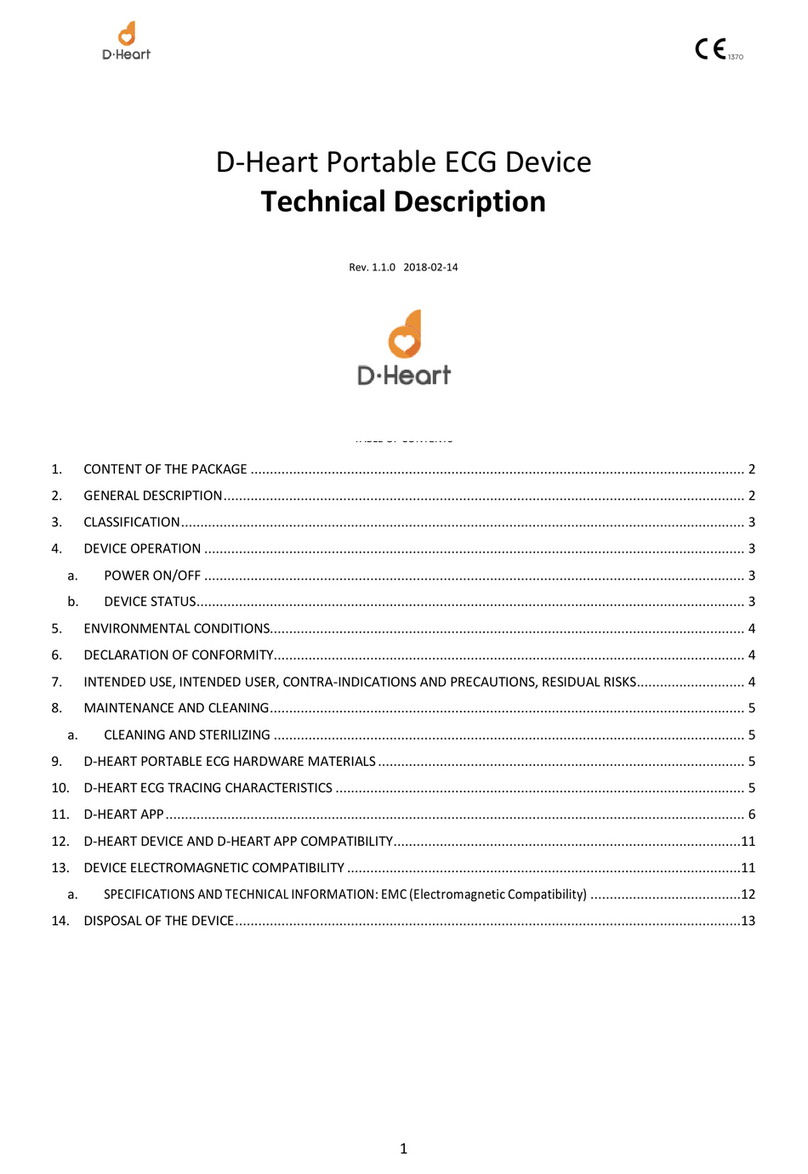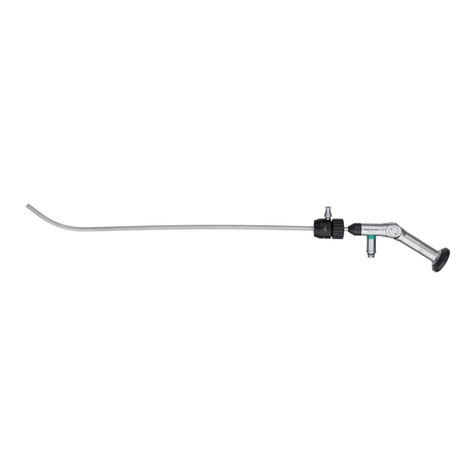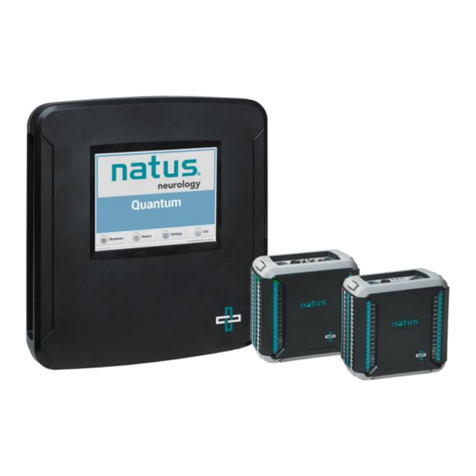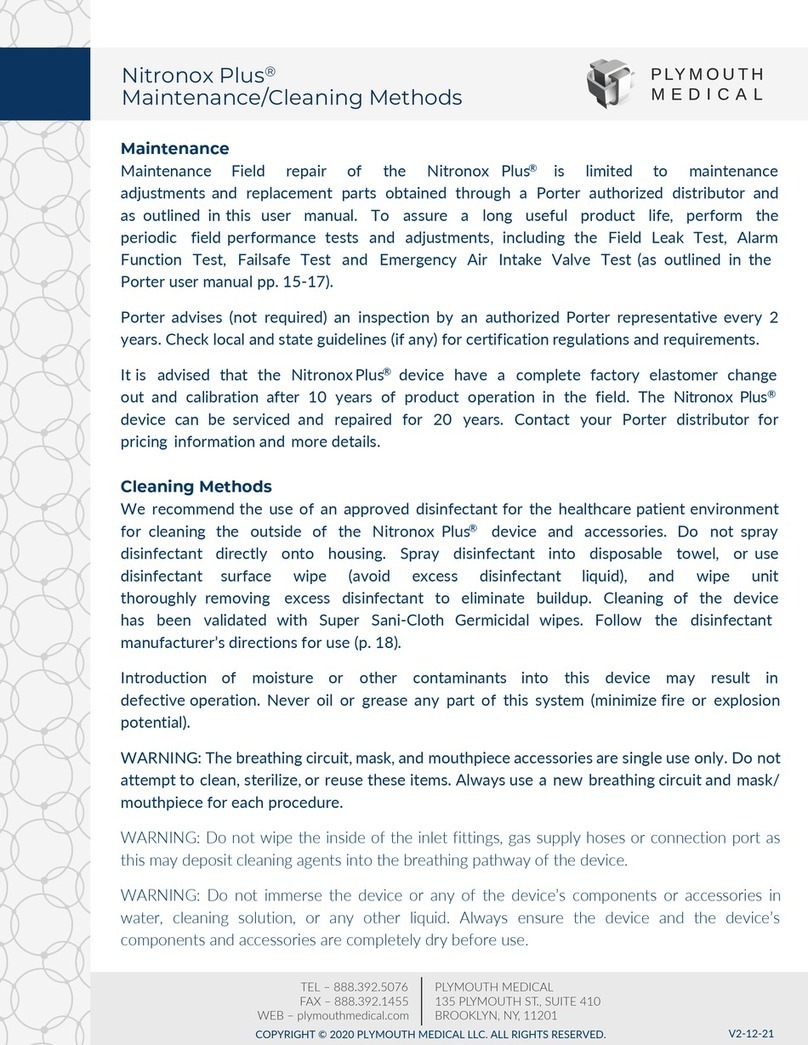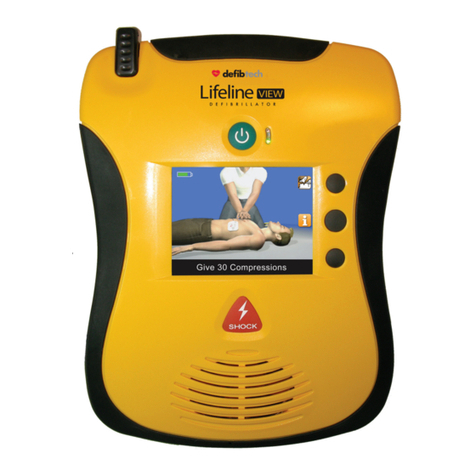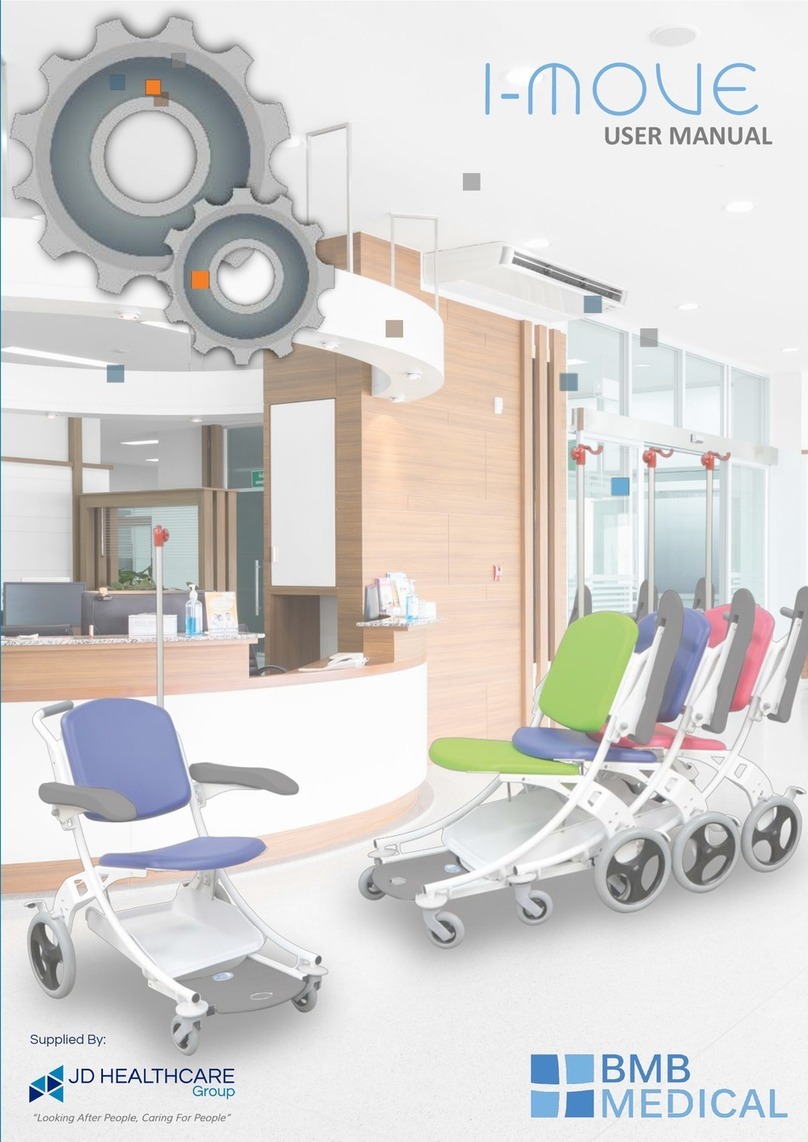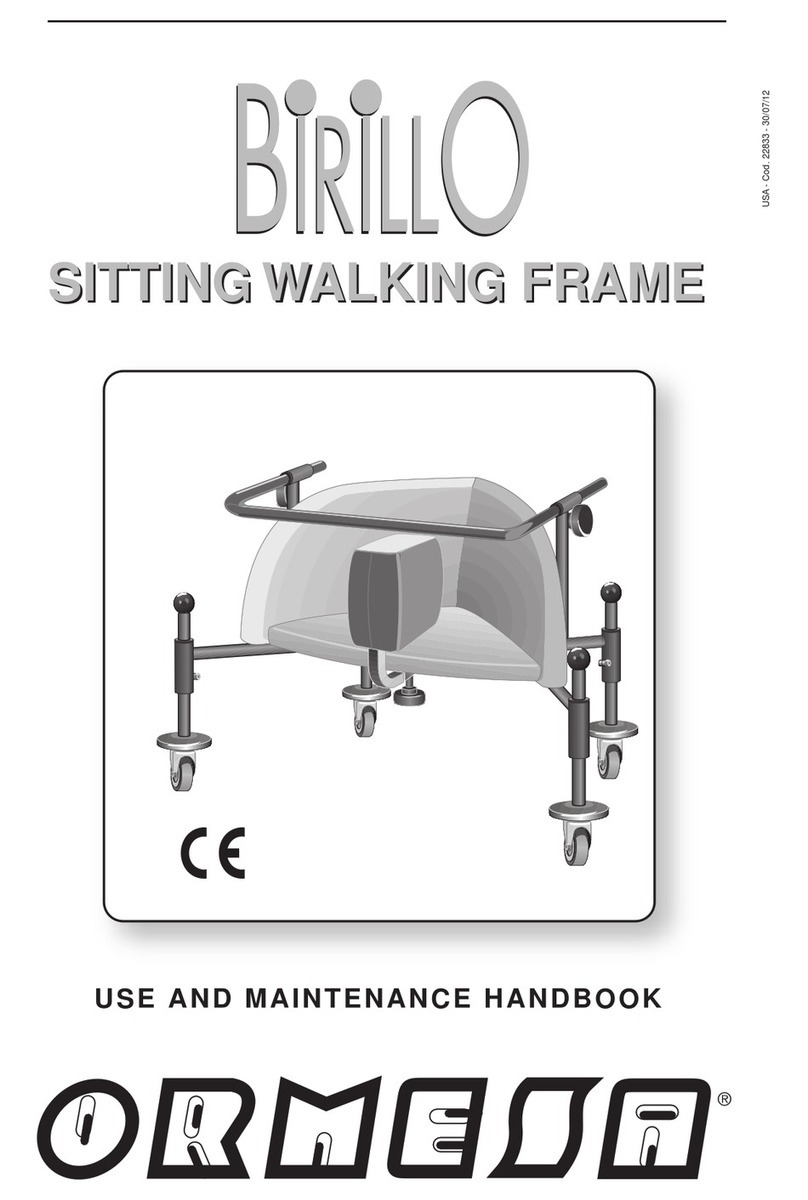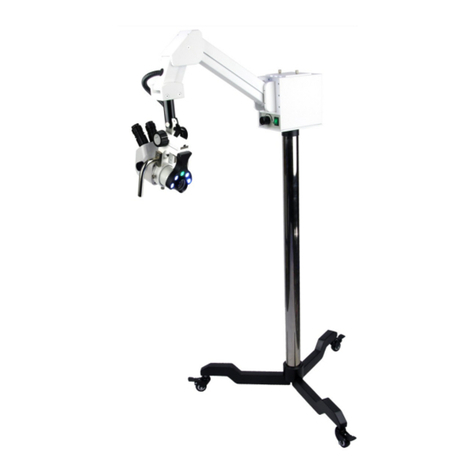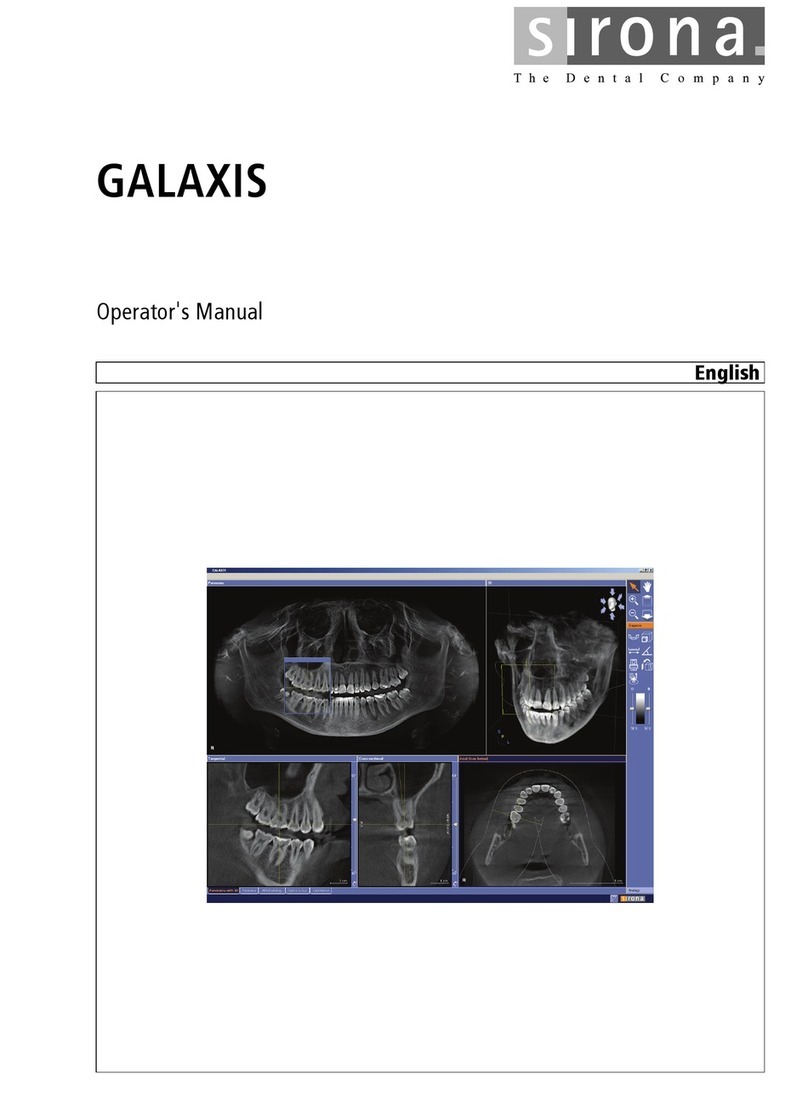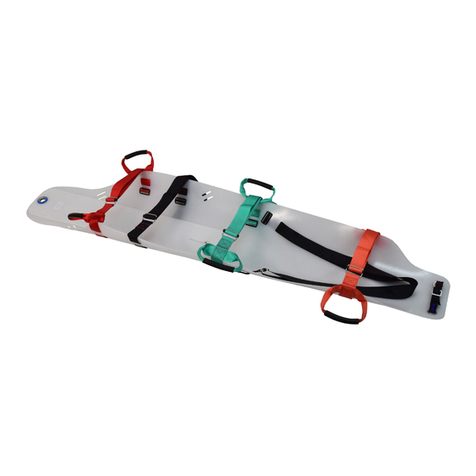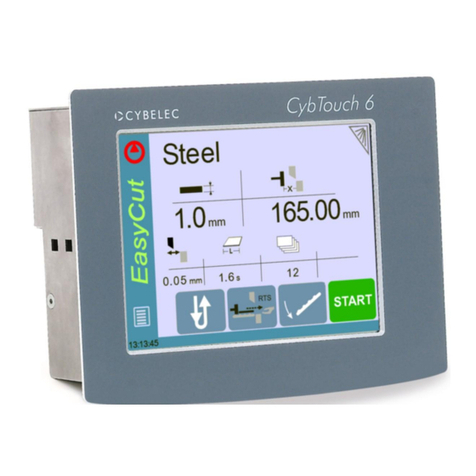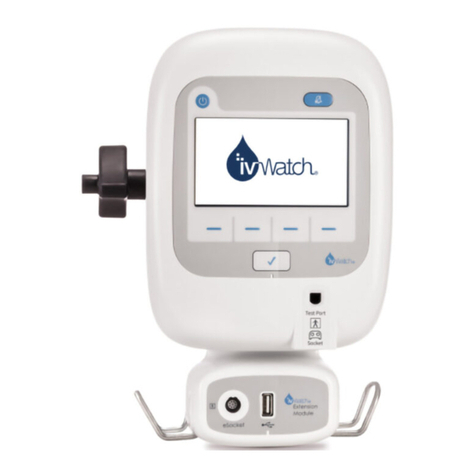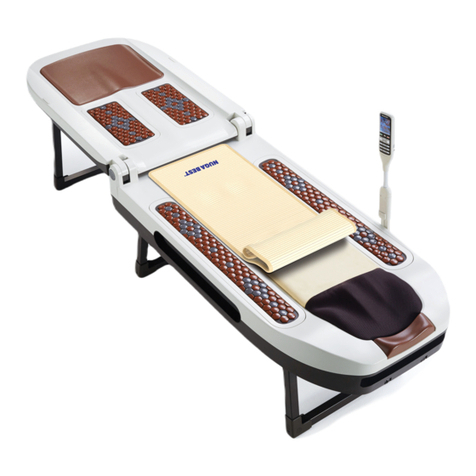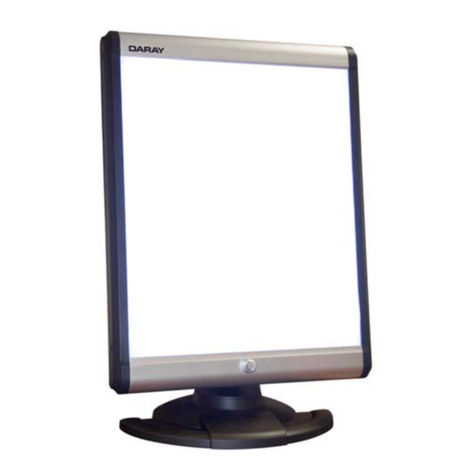D-Heart Portable ECG Device User manual

1D-Heart
D-Heart
Portable ECG Device
User Manual / Manuale Utente
Rev. 1.1.0 2018/04


User Manual Smartphone ECG Device
3D-Heart
English
Italiano
Français
Deutsch
Español
Português
Türk
4
14
24
34
44
54
64
74
84
94
104
114
124
CONTENT

4
User Manual Smartphone ECG Device
D-Heart
1. Content of the package
2. Device operation
a. Power on/o
b. Device status
3. Environmental conditions
4. Declaration of conformity
5. Intended use, intended user, contra-indications and precautions, residual risks
6. Maintenance, cleaning and troubleshooting
a. Cleaning and sterilizing
b. Maintenance
c. Troubleshooting
7. Legenda of symbols
8. Support in case of need and adverse event reporting
9. Electromagnetic compatibility
a. Specifications and technical information: EMC (electromagnetic compatibility)
10. Disposal of the device
ATTENTION! Read this manual carefully before using the instrument.
Please keep it in a safe place for future reference.
5
5
5
5
6
6
6
7
7
7
8
10
10
11
11
13
EN D-HEART PORTABLE EGC DEVICE
USER MANUAL

User Manual Smartphone ECG Device
5D-Heart
• D-Heart Portable ECG Device with lanyard 1
• Disposable electrodes
• Charging cable
• Soft case with embedded Wireless charger
• Quick Guide
a. POWER ON/OFF
• When the device is OFF (Led o), press the
central button to switch the device ON.
• When the device is ON (Led blinking), press
the central button to switch the device OFF.
b. DEVICE STATUS
• OFF (Led o)
• ON / NOT PAIRED
Led single blinking; timing: 1s
• ON / CONNECTED
Led ON (fixed)
• ON / MEASURING
Led double blinking; timing: 1s
• ON / BATTERY DISCHARGED
Led blinking 3 times; then OFF
• ON / FIRMWARE UPDATE
Led fast blinking; timing: 0,3s
• OFF / CHARGING
Led single blinking; timing: 5s
• OFF / CHARGED
Led single blinking; timing: 1,5s
1. CONTENT OF THE PACKAGE
2. DEVICE OPERATION
1In case of need, the holder of the lanyard can be detached from the D-Heart Portable ECG Device.
How to operate the device is described in the Quick Guide for D-Heart Portable ECG Device included in
the package and in the Video Tutorial available at www.d-heartcare.com.

6
User Manual Smartphone ECG Device
D-Heart
The D-Heart Portable ECG Device is compliant with the following standards:
• ETSI EN 301 489-1 V2.1.1 (2017-02)
• ETSI EN 301 489-17 V2.2.1 (2012-09)
• CEI EN 60601-1-2:2016-04
• CEI EN 60601-2-25:2016-04 (*)
• ETSI EN 300 328: v2.1.1 (2016-11)
• CEI EN 60601-1-11:2015
• CEI EN 60601-1:2005
• Operating Temp (battery discharging): -10°C to 40°C
• Operating Temp (battery charging): +5°C to +35°C
• Storage Temp: -20°C to +30°C
• Storage Humidity: 45% ~ 75% (relative)
• Atmospheric pressure range: 700 hPa to 1060 hPa
• The device is intended for supporting or providing useful information regarding the process of
diagnosis or care of users at risk for or with heart diseases.
• The device is intended to be operated in hospital, general physician’s oce, out-of-hospital
locations such as homecare environment.
• The device is intended for adults. Keep the device away from young children up high, out of sight,
and out of reach to prevent potential ingestion hazards of small parts (e.g. disposable electrodes).
• The conductive parts of electrodes should not contact any other conductive parts including earth.
• Use ONLY disposable electrodes provided with the device or other electrodes of the same model.
Contact info@d-heartcare.com to be informed on how purchasing the disposable electrodes.
• The device shall not be operated in combination with a cardiac defibrillator.
• The device shall not be operated in combination with high frequency surgical equipment.
• The device shall not be operated in combination with flammables.
• The device shall not be operated in combination with flammable anaesthetics.
• The device shall not be operated in environments saturated by oxygen.
• The device is classified as Class B according to CISPR 11:2009 (Radio-frequency disturbance
characteristics).
3. ENVIRONMENTAL CONDITIONS
5. INTENDED USE, INTENDED USER, CONTRA-INDICATIONS AND
PRECAUTIONS, RESIDUAL RISKS
4. DECLARATION OF CONFORMITY
(*) The conformity is limited to the applicable tests (as reported in the relevant Test Reports).

User Manual Smartphone ECG Device
7D-Heart
• The device is not suitable for direct cardiac application.
• An automatic check made by the D-Heart Portable ECG Device App advices and prevents the
operator from situations when the device is inoperable (e.g. not all the electrodes are connected
properly to the patient’s body).
• The ECG measurement precision could be aected by cardiac pacemaker or other electrical
stimulators.
• The minimum operating time is 24 hours provided that the battery is new and fully charged.
• The battery charge time from depletion to 90 % charge in normal use and battery conditions is 2
hours.
• In order to charge the battery the user must place the device on the wireless charger included in
the package. Battery charging is made by wireless technology.
• Don’t connect the device to the body while the battery is being charged (please note that the
device is not operative while the battery is being charged).
• After the charging has completed leave the device getting cool before putting it in contact with
the patient’s body.
• The battery charging level must be checked by the user before operating the device by using the
proper indication in the App.
• The isoelectric segments within the QRS complex are excluded from the Q-, R- or S-waves.
• The device is built in with specific filter settings to remove low-frequency components such as
motion artefact, respiratory variation, and baseline wander.
• Before executing any measurement, check the device to make sure that there is no visible damage
that may aect user’s safety and measurement performance. Stop using the unit when there is
obvious damage.
• At least on monthly basis check the availability of App and Firmware updates and make the
required upgrades accordingly.
6. MAINTENANCE AND CLEANING
a. CLEANING AND STERILIZING
• Turn othe device before cleaning. Wipe
the device with a dry and clean cloth for
cleaning. Do not allow any liquid to get in the
device.
• NEVER re-use the disposable electrodes.
b. MAINTENANCE
• Do not open the device case to avoid
damages to internal components.
• Prevent any liquid from getting in the device
as it would aect the safety and performance
of the device.
• Software and firmware upgrade are notified
to the user and automatically performed via
the Smartphone App.

8
User Manual Smartphone ECG Device
D-Heart
c. TROUBLESHOOTING
c.1 TROUBLE: The device doesn’t switch on
Possible reason Solution
The battery is drained or almost drained. Charge the battery.
The device is damaged.
Consult the following web site:
https://www.d-heartcare.com/
contact.
Possible reason Solution
The Bluetooth function of the Smartphone is switched o.Switch the Bluetooth function of
the Smartphone ON.
The Smartphone is connected to another D-Heart device. Switch the other D-Heart OFF.
The device is damaged.
Consult the following web site:
https://www.d-heartcare.com/
contact.
c.2 TROUBLE: The device doesn’t connect to the Smartphone
Possible reason Solution
Disposable electrodes don’t contact body well. Place the disposable electrodes
correctly.
The plugs are not connected to the disposable electrodes. Connect the plugs to the
disposable electrodes.
The device is damaged.
Consult the following web site:
https://www.d-heartcare.com/
contact.
c.3 TROUBLE: The automatic check in the App shows one or more disconnected
electrodes
c.4 TROUBLE: the device fails measuring the heart rate or the trace shows strong
irrelevant waveforms
Possible reason Solution
Disposable electrodes don’t not contact body well. Place the disposable electrodes
correctly.
The plugs are not connected to the disposable electrodes. Connect the plugs to the
disposable electrodes.
Movement when measuring. When measuring, please keep
quiet and avoid moving.

User Manual Smartphone ECG Device
9D-Heart
Electromagnetic interference. Keep away from interference
source.
The device is damaged.
Consult the following web site:
https://www.d-heartcare.com/
contact.
c.5 TROUBLE: the battery doesn’t charge
Possible reason Solution
Wrong position on the wireless charger.
Place the device correctly on the
wireless charger (the LED blinks
slowly).
The device is damaged.
Consult the following web site:
https://www.d-heartcare.com/
contact.

10
User Manual Smartphone ECG Device
D-Heart
Please consult the following web site: https://www.d-heartcare.com/contact
for assistance, if needed, in setting up, using or maintaining the D-Heart Portable ECG Device or to
report unexpected operation or events.
Adverse event should be reported. Reporting form and information can be found at
http://www.salute.gov.it. Adverse events related to D-Heart Portable ECG device should also be
reported to D-Heart Srl on 0039 010 3017000
The D-Heart Portable ECG Device
is certified according to the
relevant recommendations set
by the European Community for
electromedical devices (93/42/
CEE). The number “1370” identifies
the notified body that verifies the
compliance of the device to the
applicable essential requirements.
The D-Heart Portable ECG Device
is protected against water and dust
with the level of protection IP22 as
defined by the IEC standard 60529:
• The enclosure provides
protection to access to
hazardous parts for Fingers or
similar objects
• The enclosure provides
protection to Dripping water
when tilted at 15°
Separate collection for Waste of
Electric and Electronic Equipment
(WEEE).
Range of temperature.
Manufacturer.
Range of atmospheric pressure.
The D-Heart Portable ECG
Device supports the Bluetooth®
technology.
Range of humidity.
The D-Heart Portable ECG Device
is classified as TYPE CF regarding
the protection against electrical
shock according to standard CEI
EN 60601-2-25.
Keep dry: store and use the device
in a dry environment.
8. SUPPORT IN CASE OF NEED AND ADVERSE EVENT REPORTING
7. LEGENDA OF SYMBOLS
1370

User Manual Smartphone ECG Device
11D-Heart
This device is classified in class B according to IEC60601-1-2.
This instrument has been tested and found to comply with the limits for medical devices to the
IEC60601-1-2 and Medical Device Directive 93/42/EEC. These limits are intended to provide
reasonable protection against harmful interference in a typical medical environment. This instrument
generates, uses and can radiate radio frequency energies and, if not put in service and used in
accordance with the instructions, may cause harmful interference to other devices in the vicinity.
However, there is no guarantee that interference will not occur in a particular location.
If the system does cause harmful interference to other devices, which can be determined by turning
the system oand on, try to eliminate the interference by adopting one or more of the following
measures:
• reorient and/or relocate the receiving device;
• increase the distance between the devices;
• connect the system to an outlet on a dierent circuit than that to which the other devices is
connected;
• consult the manufacturer or field service technician for help.
9. ELECTROMAGNETIC COMPATIBILITY
Essential performance: continuous operation (measurement status).
a. SPECIFICATIONS AND TECHNICAL INFORMATION: EMC (ELECTROMAGNETIC COMPATIBILITY)
Guidance and manufacturer’s declaration - electromagnetic emissions
The device is intended for use in the electromagnetic environment specified below. The customer
or the user of the device should assure that it is used in such an environment.
Emissions test Compliance Electromagnetic environment - guidance
RF emissions CISPR 11 Group 1
The device uses RF energy only for its internal
function. Therefore, its RF emissions are very
low and are not likely to cause any interference
in nearby electronic equipment.

12
User Manual Smartphone ECG Device
D-Heart
Guidance and manufacturer’s declaration - electromagnetic immunity
The device is intended for use in the electromagnetic environment specified below. The customer
or the user of the device should assure that it is used in such an environment.
Immunity test Compliance level
ETSI EN 301 489-1 V1.9.2 (2011-09)
Electromagnetic compatibility and Radio spectrum Matters
(ERM)
Electromagnetic Compatibility (EMC) standard for radio
equipment and services
Part 1: Common technical requirements
ETSI EN 301 489-17 V2.2.1 (2012-09)
Electromagnetic compatibility and Radio spectrum Matters
(ERM)
Electromagnetic Compatibility (EMC) standard for radio
equipment
Part 17: Specific conditions for Broadband Data Transmission
Systems
CEI EN 60601-1-2:2016-04
EN 60601-1-2:2015-09
IEC 60601-1-2:2014-02
Medical electrical equipment - Part 1-2: General requirements
for basic safety and essential performance - Collateral Standard:
Electromagnetic disturbances - Requirements and tests
10 V/m
80 MHz to 2.7 GHz
ETSI EN 301 489-1 (V2.2.0)
ElectroMagnetic Compatibility (EMC)
standard for radio equipment and services;
Part 1: Common technical requirements
ETSI EN 301 489-17 (V2.2.1)
ElectroMagnetic Compatibility (EMC)
standard for radio equipment and services;
Part 17: Specific conditions for
Broadband Data Transmission Systems
3 V/m
2.7 GHz to 6.0 GHz
Electrostatic Discharge
According to IEC 61000-4-2
± 8 kV contact
± 2 kV, ± 4 kV, ± 8 kV, ± 15 kV
air
CEI EN 60601-1-2:2016-04
EN 60601-1-2:2015-09
IEC 60601-1-2:2014-02
Medical electrical equipment - Part 1-2: General requirements for basic safety and essential
performance - Collateral Standard: Electromagnetic disturbances - Requirements and tests

User Manual Smartphone ECG Device
13D-Heart
Guidance and manufacturer’s declaration – electromagnetic emissions
The device is intended for use in the electromagnetic environment specified below. The customer
or the user of the device should assure that it is used in such an environment.
Emission test Compliance Criteria
ETSI EN 300 328: v2.1.1 (2016-11)
Data transmission equipment operating in the 2,4 GHz ISM
band and using wide band modulation techniques;
Harmonised Standard covering the essential requirements of
article 3.2 of the Directive 2014/53/EU
All requirements are met
Proximity fields from RF wireless communications equipment
According to IEC 61400-4-3
CEI EN 60601-1-2:2016-04 Table 9
test level applied
Rated Power magnetic fields
According to IEC 61000-4-8
30 A/m
50 Hz and 60 Hz
10. DISPOSAL OF THE DEVICE
According to Directive 2012/19/EU of the European Parliament and of the Council.4 July 2012 on
waste electrical and electrical equipment (WEEE):
The crossed-out wheeled bin symbol printed either on the equipment or on the package indicates
that the product shall be disposed separately from other waste at the end of its life cycle and that the
user shall deliver the old equipment to collection centers authorized for electrical waste, alternatively
the old equipment shall be sent back at the time of the purchasing of a new equipment of the same
model in one-to-one proportion. The old equipment can be delivered either to the reseller or to the
manufacturer D-HEART srl at the time of the delivery of the new equipment.
The correct disposal of waste according to the instructions above helps in preventing potential
drawbacks for the environment and the public health and helps the recycling of the materials the
equipment is made of. The incorrect disposal of the equipment is subject to administrative sanctions
according to the existing law.

Manuale Utente Smartphone ECG Device
D-Heart14
1. Contenuto della confezione
2. Funzionamento del dispositivo
a. Accensione / Spegnimento
b. Stati del dispositivo
3. Condizioni ambientali di utilizzo
4. Dichiarazione di conformità
5. Uso previsto, utenti previsti, controindicazioni e precauzioni, rischio residuo
6. Manutenzione, pulizia e risoluzione dei problemi
a. Pulizia e sterilizzazione
b. Manutenzione
c. Risoluzione dei problemi
7. Legenda dei simboli
8. Supporto in caso di necessità
9. Compatibilità elettromagnetica
a. Specifiche e informazioni tecniche: EMC (Compatibilità ElettroMagnetica)
10. Smaltimento del dispositivo
ATTENZIONE: leggere attentamente questo manuale prima di utilizzare il dispositivo.
Si prega di conservare il manuale in luogo sicuro per riferimento futuro.
IT ELETTROCARDIOGRAFO PORTATILE D-HEART
MANUALE UTENTE
15
15
15
15
16
16
16
17
17
17
18
20
20
21
21
23

Manuale Utente Smartphone ECG Device
15D-Heart
• Elettrocardiografo Portatile D-Heart con laccetto per essere indossato al collo.1
• Elettrodi monouso
• Cavo per ricarica
• Borsetta con caricabatteria wireless (senza fili) integrato
• Guida rapida all’utilizzo
a. ACCENSIONE / SPEGNIMENTO
• Quando il dispositivo è SPENTO (Led spento),
premere il bottone centrale per accendere il
dispositivo.
• Quando il dispositivo è ACCESO (Led
lampeggiante), premere il bottone centrale
per spegnere il dispositivo.
b. STATI DEL DISPOSITIVO
• SPENTO (Led spento)
• ACCESO / NON COLLEGATO
(via Bluetooth allo smartphone)
• Led lampeggiante / lampeggio singolo ogni:
1 sec.
• ACCESO / COLLEGATO
(via Bluetooth allo smartphone)
• Led ACCESO (luce fissa)
• ACCESO / IN MISURA
• Led lampeggiante / doppio lampeggio ogni:
1 sec.
• ACCESO / BATTERIA SCARICA
• Led lampeggiante rapidamente 3 volte e
successivamente il dispositivo si spegne
• ACCESO / AGGIORNAMENTO FIRMWARE IN
CORSO
• Led lampeggiante rapidamente ogni: 0,3 sec.
• SPENTO / IN CARICA
• Led lampeggiante / lampeggio singolo ogni:
5 sec.
• SPENTO / DISPOSITIVO CARICO
• Led lampeggiante / lampeggio singolo ogni:
1,5 sec.
1. CONTENUTO DELLA CONFEZIONE
2. FUNZIONAMENTO DEL DISPOSITIVO
1In caso di necessità il gancio del laccetto può essere staccato dall’Elettrocardiografo Portatile D-Heart.
Le modalità di utilizzo del dispositivo sono descritte nella Guida Rapida dell’Elettrocardiografo
Portatile D-Heart per Smartphone inclusa nella confezione e nel Video Informativo disponibile al sito:
www.d-heartcare.com

Manuale Utente Smartphone ECG Device
D-Heart16
L’Elettrocardiografo Portatile D-Heart è conforme alle seguenti normative:
• ETSI EN 301 489-1 V2.1.1 (2017-02)
• ETSI EN 301 489-17 V2.2.1 (2012-09)
• CEI EN 60601-1-2:2016-04
• CEI EN 60601-2-25:2016-04 (*)
• ETSI EN 300 328: v2.1.1 (2016-11)
• CEI EN 60601-1-11:2015
• CEI EN 60601-1:2005
• Temperatura operativa (batteria in scarica): da -10°C a 40°C
• Temperatura operativa (batteria in carica): da +5°C a +35°C
• Temperatura di stoccaggio: da -20°C a +30°C
• Umidità di stoccaggio: 45% ~ 75% (relativa)
• Intervallo di pressione atmosferica: da 700 hPa a 1060 hPa
• Il dispositivo è destinato a supportare o fornire informazioni utili relativamente al processo di
diagnosi o cura di utenti a rischio di o aetti da malattie cardiache.
• Il dispositivo è destinato all’utilizzo in strutture ospedaliere, ambulatori medici ed ambienti al di
fuori delle strutture ospedaliere inclusi gli ambienti domestici.
• Il dispositivo è destinato ad essere utilizzato da persone adulte. Tenere il dispositivo fuori dalla
portata o dalla vista di bambini per evitare il rischio di ingerimento di piccole parti (ad esempio:
elettrodi monouso).
• Le parti conduttive degli elettrodi non devono venire a contatto con altre parti conduttive, inclusa
la terra.
• Utilizzare ESCLUSIVAMENTE gli elettrodi forniti col dispositivo o altri elettrodi dello stesso
modello. Contattare info@d-heartcare.com per le modalità di acquisto degli elettrodi monouso.
• Il dispositivo non deve essere utilizzato assieme ad un defibrillatore cardiaco.
• Il dispositivo non deve essere utilizzato assieme a strumentazione chirurgica ad alta frequenza.
• Il dispositivo non deve essere usato assieme a materiali infiammabili.
• Il dispositivo non deve essere usato assieme ad anestetici infiammabili.
• Il dispositivo non deve essere usato in un ambiente saturo di ossigeno.
3. CONDIZIONI AMBIENTALI DI UTILIZZO
5. USO PREVISTO, UTENTI PREVISTI, CONTROINDICAZIONI E PRECAUZIONI,
RISCHIO RESIDUO
4. DICHIARAZIONE DI CONFORMITÀ
(*) La conformità è limitata ai test applicabili (come riportato nei relativi Test Report).

Manuale Utente Smartphone ECG Device
17D-Heart
• Il dispositivo è classificato in Classe B secondo la normativa CISPR 11:2009 (Caratteristiche di
disturbo in radiofrequenza).
• Il dispositivo non è adatto ad applicazione cardiaca diretta.
• Una verifica automatica eettuata dall’App dell’Elettrocardiografo Portatile D-Heart avvisa
l’utilizzatore di situazioni in cui il dispositivo non è utilizzabile (ad esempio quando non tutti gli
elettrodi sono collegati correttamente al corpo del paziente).
• La misura dell’elettrocardiografo può essere alterata dalla presenza di pacemaker o altri stimolatori cardiaci.
• La durata minima di funzionamento è di 24 ore a condizione che la batteria sia nuova
e completamente carica.
• Il tempo di carica della batteria dallo stato di scarica completa fino a 90% di carica è di 2 ore.
• Per la ricarica posizionare la batteria nell’apposito alloggiamento della borsetta.
La ricarica viene eettuata utilizzando tecnologia wireless (senza cavo).
• Non collegare il dispositivo al corpo durante la ricarica (si consideri anche che il dispositivo non è
operativo nel corso della ricarica).
• Dopo il completamento della ricarica, attendere che il dispositivo si rareddi prima di metterlo a
contatto col corpo del paziente.
• Prima di utilizzare il dispositivo, il livello di carica della batteria deve essere verificato mediante
l’apposita indicazione presente nell’App.
• I segmenti isoelettrici all’interno del complesso QRS sono esclusi dalle onde Q-, R- o S-.
• Il dispositivo è costruito con specifiche impostazioni di filtraggio per rimuovere le componenti
a bassa frequenze quali: artefatti dovuti al movimento, variazioni dovute alla respirazione e
fluttuazioni della linea di base.
• Prima di eseguire la misura, assicurarsi che sul dispositivo non sia presente alcun danno visibile
che possa influire sulla sicurezza dell’utente o sulla prestazione di misura. Sospendere l’utilizzo del
dispositivo in caso di danno evidente.
• Verificare con frequenza minima di un mese la disponibilità di aggiornamenti dell’App o del
firmware ed eettuare gli aggiornamenti eventualmente previsti.
6. PULIZIA E MANUTENZIONE
a. PULIZIA E STERILIZZAZIONE
• Spegnere il dispositivo prima di pulirlo.
Strofinare il dispositivo con un panno asciutto
e pulito. Evitare l’introduzione di liquidi nel
dispositivo.
• Non riutilizzare MAI gli elettrodi monouso.
b. MANUTENZIONE
• Non aprire il dispositivo per evitare il
danneggiamento dei componenti interni.
• Evitare l’introduzione di qualsiasi liquido
nel dispositivo al fine di evitare problemi di
sicurezza o di funzionamento.
• La disponibilità di aggiornamenti del
software e/o del firmware viene notificata
all’utilizzatore; l’aggiornamento viene
eettuato automaticamente mediante l’App
D-Heart sullo Smartphone.

Manuale Utente Smartphone ECG Device
D-Heart18
c. RISOLUZIONE DEI PROBLEMI
c.1 PROBLEMA: Il dispositivo non si accende
Possibile causa Soluzione
La batteria è scarica o quasi scarica. Caricare la batteria.
Il dispositivo è guasto. Consultare il sito web:https://
www.d-heartcare.com/contact
Possibile causa Soluzione
La funzionalità Bluetooth dello Smartphone è disattivata. Attivare la funzionalità Bluetooth
dello Smartphone.
Lo Smartphone è collegato ad un altro dispositivo D-Heart. Spegnere l’altro dispositivo
D-Heart.
Il dispositivo è guasto. Consultare il sito web:https://
www.d-heartcare.com/contact.
c.2 PROBLEMA: Il dispositivo non si collega allo Smartphone
Possibile causa Soluzione
Gli elettrodi monouso non sono perfettamente a contatto col
corpo.
Posizionare correttamente gli
elettrodi monouso.
I terminali non sono collegati agli elettrodi monouso. Collegare I terminali agli elettrodi
monouso.
Il dispositivo è guasto. Consultare il sito web:https://
www.d-heartcare.com/contact
c.3 PROBLEMA: la verifica automatica eettuata dall’App indica che uno o più elettro-
di non sono collegati
Possibile causa Soluzione
Gli elettrodi monouso non sono perfettamente a contatto col
corpo.
Posizionare correttamente gli
elettrodi monouso.
I terminali non sono collegati agli elettrodi monouso. Collegare I terminali agli elettrodi
monouso.
Movimenti durante la misura. Durante la misura restare fermi ed
evitare qualsiasi movimento.
c.4 PROBLEMA: il dispositivo non rileva il battito cardiaco o la traccia presenta forme
d’onda fortemente anomale
Interferenza elettromagnetica. Tenere il dispositivo lontano dalle
sorgenti di interferenza.
Il dispositivo è guasto. Consultare il sito web:https://
www.d-heartcare.com/contact

Manuale Utente Smartphone ECG Device
19D-Heart
c.5 PROBLEMA: la batteria non si carica
Possibile causa Soluzione
La posizione sul caricabatteria wireless non è corretta.
Posizionare il dispositivo sul
caricabatteria wireless in modo
corretto (il LED lampeggia
lentamente).
Il dispositivo è guasto. Consultare il sito web:https://
www.d-heartcare.com/contact

Manuale Utente Smartphone ECG Device
D-Heart20
Siete pregati di consultare il seguente sito web: https://www.d-heartcare.com/contact
per assistenza, se necessario, nell’avvio, utilizzo o manutenzione del prodotto D-Heart o per riportare
modalità di funzionamento o eventi inattesi. Siete pregati di segnalare qualsiasi evento avverso.
Il modulo di segnalazione e le relative informazioni possono essere reperite al link http://www.salute.
gov.it. Si prega di segnalare qualsiasi evento avverso relativo all’Elettrocardiografo Portatile D-Heart
anche a D-Heart Srl al numero: 0039 010 3017000.
L’elettrocardiografo Portatile
D-Heart è certificato secondo le
relative raccomandazioni definite
dalla Comunità Europea per i
dispositivi elettromedicali (93/42/
CEE). Il numero “1370” identifica
l’ente notificato che verifica la
conformità del dispositivo ai
requisiti essenziali applicabili.
L’elettrocardiografo Portatile
D-Heart è protetto da acqua e
polveri col livello di protezione IP22
come definito dallo standard IEC
60529:
• L’involucro fornisce protezione
rispetto all’accesso alle parti
pericolose da parte
di dita umane od oggetti di
dimensioni comparabili
• L’involucro fornisce protezione
rispetto ad acqua gocciolante in
condizioni di inclinazione fino a 15°
Raccolta dierenziata per I
materiali di scarto di apparati
elettrici ed elettronici (WEEE).
Intervallo di temperatura.
Fabbricante.
Intervallo di pressione atmosferica.
L’elettrocardiografo Portatile
D-Heart supporta la tecnologia
Bluetooth®.
Intervallo di umidità.
L’elettrocardiografo Portatile
D-Heart è classificato come TIPO
CF con riferimento alla protezione
da shock elettrico secondo lo
standard CEI EN 60601-2-25.
Tenere all’asciutto: immagazzinare
ed utilizzare il dispositivo in un
ambiente asciutto.
8. SUPPORTO IN CASO DI NECESSITÀ E SEGNALAZIONI DI EVENTO AVVERSO
7. LEGENDA DEI SIMBOLI
1370
Table of contents
Languages:
Other D-Heart Medical Equipment manuals
